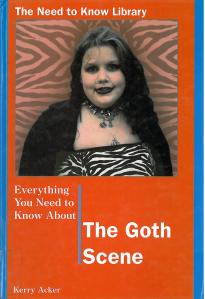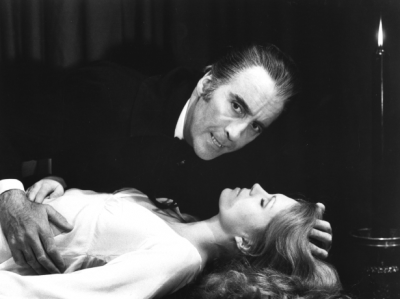Archive for the ‘Books’ Category
Everything? Really? [part 3]
July 11th, 2012 Posted 6:33 am

Cover, Everything You Need to Know About the Goth Scene
Acker, Kerry. Everything You Need to Know About The Goth Scene. New York: The Rosen Publishing Group, 2000.
Continued from Part 1 and Part 2.
Chapter 4/Gothic Fashion: Fashion is an important aspect of Goth culture. Just as many other people in the world, Goths use fashion, hairstyle, and makeup to express themselves. Lady Gaga certainly does and I’m not sure anyone would accuse her of being Goth. 🙂
While there are some styles that tend to identify someone as Goth, I know many goths who were little other than jeans and black t-shirts. I’m personally most comfortable in long skirts and t-shirts. The husband is most comfortable in a complete outfit, styled head to toe, in a manner that will make him stand out. He’s known for it. Neither Jordan or Alek really embrace the fashion of the culture. Jordan does wear primarily black tshirts and jeans, but I can’t tell you that is a conscious decision or for any reason other than it’s what he likes. Alek wears bright colors – basketball shorts and tshirts, or dress shirts and khakis. Ravynn and Whisper like pretty clothes in any color. They do like a lot of black, but they’re little girls so pink and baby blue show up in their choices a lot. As far as we’re concerned, I believe that whatever in us determines our fashion choices, its’ the same thing that draws us to the Goth culture. Maybe. It’s just a theory.
 Acker lists several items common to Goth fashion:
Acker lists several items common to Goth fashion:
- Black or dark-colored velvet skirts, dresses, and vests
- Doc Martens or combat boots
- White poet’s shirts
- Rubber, leather, or vinyl gear
- Corsets
- Pagan or Christian jewelry
- Buckles, pointy shoes, and ripped fishnets
I see so much more than that, but it’s not a bad list. It’s also not bad [although slightly obvious] tha black is the color of choice for goth-minded folks. You’ll notice, though, that Eric isn’t afraid of a splash [or more] of color in his outfits. The author also spends a lot of time discussing the ways that MANY Goths wear their hair or the MANY kids of jewelry MANY of them wear. Really, some experiment with hairstyles and some wear a lot of jewelry.
Chapter 5/Gothic Music, Literature, and Film: The main part of the book conclude with lists of popular music, literature, and film. The book is 12 years old, so none of these are current lists. I suggest you Google up the lists or just ask.
There is more to be learned from just talking to people than from reading. While the book doesn’t offer wrong information, the way some of it is presented is misleading.
Tags: everything you need to know, fashion, hairstyles, jewelry, makeup, movies, musics, what is goth
Posted in Books
Everything? Really? [part 2]
July 8th, 2012 Posted 6:33 am

Cover, Everything You Need to Know About the Goth Scene
Acker, Kerry. Everything You Need to Know About The Goth Scene. New York: The Rosen Publishing Group, 2000.
Continued from Part 1.
Chapter 2/Gothic Philosophy: Sigh. I think the final thought in Chapter 1 would suffice. Acknowledging both the good and bad of human nature and the world in order to fully appreciate both. Then there is a shift to suggesting that Goths focus on the dark and the bad and place emphasis on suffering, sorrow, fear, and death. While I do picnic in cemeteries [we have one scheduled for July 29th – see our Facebook page for details], I don’t focus on any of those things. I don’t mean to suggest that my experience is shared by everyone, but I do mean to suggest that acknowledging the darker things does not necessarily equate to a focus on them. It’s just so different from the experience of “normal” people that it might look like a focus. I don’t know. I’m still trying to figure out the angle of this book.
Knowing more about the author than “is a freelance writer” would help a lot. Either they [Kerry could be either male or female] are Goth and trying to honestly explain the culture, but are doing it poorly, or they are not Goth and writing a resource book with a poor understanding of the culture. Even still, maybe an editor made a mess of a perfect book. The world may never know.
Dictionary.com defines Philosophy as:
1. the rational investigation of the truths and principles of being, knowledge, or conduct.
2. any of the three branches, namely natural philosophy, moral philosophy, and metaphysical philosophy, that are accepted as composing this study.
3. a system of philosophical doctrine: the philosophy of Spinoza.
4. the critical study of the basic principles and concepts of a particular branch of knowledge, especially with a view to improving or reconstituting them: the philosophy of science.
5. a system of principles for guidance in practical affairs.
6. a philosophical attitude, as one of composure and calm in the presence of troubles or annoyances.
None of those seem appropriate – at all; however, Dictionary.com defines aesthetic as: having a sense of the beautiful; characterized by a love of beauty. BINGO!
The “Who are Goths?” section of this chapter states, “followers of the Goth aesthetic include people of different ages, sensibilites, religions, politics, and careers… Goths are a group of people with broad interests such as history, literature, music, mythology, and fashion.” Good. True. But sadly, the rest of the book attempts to force goths into little boxes in order for it to truly be understood. I’m not sure this is intentional. I suspect the author is attempting to bring light [haha] to the darker aspects and forgets to mention that this isn’t ALL there is. An attraction to darkness can attract people to Goth culture – really, not everyone “gets it,” but we do appreciate the things that non-Goths do as well. This book seems to try to force a separation where one is not necessary and every chapter includes a warning to look for signs for violence and depression.

Christopher Lee as Dracula
A picture of Dracula [not the one I chose because I’m more of a Christopher Lee fan] holds the caption, “Many Goths are fascinated with the mystery of death and the occult,” BUT MANY ARE NOT. I’m sure that reminder would become annoying and overhelming, but it’s so necessary.
Chapter 2/Gothic Lifestyle: An overview of humans in general… A wide range of interests [including music, fashion, other hobbies enjoyed alone or in a group], the opportunity to experiment with sexuality [specifically with gender roles], and interest in different religions [or in no religion, although the focus here is in Paganism and Vampirism, with a note on Christianity].
After reviewing the aspects of the Gothic Lifestyle presented and noting the points made which are 90% pointing out how different Goths are from most of the people in the world, Acker warns us about subscribing to stereotypes.
Perhaps I am just thin-skinned on this topic. I show people the similarities between them and me and then let them notice the differences. One of the girls I work with says all the time, “You’re just a normal person. Why are people so freaked out by you?”
Why indeed.
[more to follow…]
Tags: everything you need to know, fashion, philosophy, religion, vampires, what is goth
Posted in Books
Everything? Really? [part 1]
July 5th, 2012 Posted 6:33 am

Cover, Everything You Need to Know About the Goth Scene
Acker, Kerry. Everything You Need to Know About The Goth Scene. New York: The Rosen Publishing Group, 2000.
On a recent trip to the library, the girls and I picked out some summer reading books for them and their brothers. They’re not what most people would consider. Jordan wants to teach himself Calculus; Alek wants to review Algebra; Ravynn wants to teach herself Algebra; and Whisper just wants to get ready for 4th grade.
With the idea of reading and reviewing some books on Goth culture – just to see what information is being presented to the non-Goth public – I did a quick search while we were there. Being that we live in a town of 56,000, I didn’t expect to find much. I was excited and surprised to find four titles listed. I went to find them. three were available and one has been either lost or stolen [of course, that’s the one I’m most interested in reading].
I’m a working mama with a busy schedule, four kids, a full-time job, and a home business, so I did plan to start with the smallest book. As I pulled out the Everything you Need to Know title, I was tempted to put it right back. My problem with it? Quite simply, the cover. I couldn’t imagine a book that offered that image as the representation of the Goth culture would provide any useful information – and I fully expected to be annoyed with what it did provide. Now, I know the cover model could be a lovely young woman with a charming outlook on life, but when I look at her, I see one thing – ROOTS!! While I try not to overgenarlize or stereotype, Goths are a people typically drawn to beauty and border on the vain. Many of the Goths I know (the husband included) wear their vanity as a badge – that photo doesn’t fly.
But that photo wouldn’t keep everyone from reading it, so we popped into Panera, ordered iced acai teas, and started reading. Actually, we finished reading too. The book is 65 pages long. Minus 9 pages of introduction and 21 pages of lists, glossary, index, and reading lests at the end of the book, it totals 35 pages. Ravynn and Whisper were with me and were pretty entertained with what I was reading to them. Of course there was a lot I had to explain. Starting with:
The Introduction: I had to keep reminding myself that the pub date on the title is 2000 and there is a lot of information that was assumed truth at that date that isn’t so much anymore. The focus of the intro is on the shootings at Columbine High school and how just because those Goths were bad and dangerous doesn’t mean that all of us are. I wanted a reminder that although they were described as Goth by one witness, that it’s not so much true, but it didn’t come. The most helpful bit in the introduction is where Acker writes, “People judge Goths based on their clothing tastes and their appearance, instead of getting to know them by talking with them, hearing their ideas, and trying to find things in common with them.” This is true. I’ve lived it. The introduction also explains why I believe the book failed: It confuses explaining the Goth scene with explaining Goths. Phrases like, “some Goths,” or “many Goths” put me on edge. While explaining what draws some individuals to the culture is helpful and refreshing, explaining the “kinds of people” who are drawn to it isn’t.
Chapter 1/The Origins of Goth: Blah, blah, blah. The first half of the chapter focuses on historical Goths and their invasion of Rome. While this is commonly covered in articles on the culture, I fail to see its relevance. What Acker refers to as “Contemporary Goth” is what she means to explain.
Bauhaus’s “Bela Lugosi’s Dead” is often marked as the begining of Goth music. I don’t know if it’s true, but it sounds good and I do adore Peter Murphy. Acker discusses how Goth bands influenced the “look” associated with the Goth culture [black clothes, black hair, pale skin]. Most of the discussion on the culture focuses on the music, but does touch on what we have tried to explain to anyone who asks or expresses interest [especially the Wife Swap producers!]: “Goths wanted to experience emotions, good and bad, because they are an essential part of being human… Goths also established a different idea of beauty — a new aesthetic.”
See Part 2.
Tags: bauhaus, columbine, education, everything you need to know, reseach, what is goth
Posted in Books
Embrace
January 6th, 2011 Posted 12:08 pm
![]()
Our family isn’t typical…
My boys dance. Eric guest performs. Jordan studied for 7 years. Alek still does. Most recently, he appeared as Harlequin in our local production of the Nutcracker. He’s very talented and we’re very proud of him. They began dancing when they were 4 and have worked hard at one of the best studios in the Midwest. When Ravynn turned 4, the boys came to me concerned. She wanted to take ballet, too, but they worried that it was only for boys [never mind that their classes had always been full of girls]. They were incredibly pleased when we bought a tiny pair of pink ballet shoes. It wasn’t until a minor incident in 4th grade when they felt the bullying effects of being different. A very kind teacher explained what exactly was the problem with the phrase ‘ballerina boy’ and it mostly ended. There are still comments flung around, but Alek who’s 12 and in 7th grade is strong and ignores them.

Our family is goth. Locally, we’re semi-famous for it, but you may have noticed from other comments or photos or even the About page associated with this blog. Eric and I embrace being different, but each of the kids have at points heard rumors or fielded snotty comments based on how we look or dress. It’s a great opportunity to talk to them about stereotypes and prejudice and about not having to conform to make other people happy. For the most part they get it, but I understand [having been a 10 year old girl once upon a time] that there is still a sting involved. I hate that. At the same time they love when their friends think we’re cool because of the way we dress or the music we listen to. I kinda like being famous at the elementary school, but not to the detriment of my kids.
When I read news stories about bullied kids or hear about it from fellow moms, my heart aches. No child should have an unhappy childhood. I mean there are some situations that cannot be avoided and the pain of them cannot be minimized, but… if the pain is caused by other kids or adults being hateful and unaccepting. Well, the simple fact is that should be easy to change.
Several weeks ago, a Facebook post brought my attention to the blog, Portrait of an Adoption. Young Katie was being teased for wanting to carry a Star Wars water bottle to school. Three cheers for social networking. Geek Girls came out in force to support Katie. As I understand, Geeks, Nerds, and Dorks all came out to support her and give her strength. I think this is awesome! It’s what I’ve tried to teach my own kids. Differences should be Celebrated. Sometimes they are, as with Katie’s situation.
Checking on Portrait of an Adoption, I read the story of author Cheryl Kilodavis and her book My Princess Boy. Her website explains it as:
 My Princess Boy is a nonfiction picture book about acceptance. It tells the tale of a 4-year-old boy who happily expresses his authentic self by enjoying “traditional girl” things like jewelry, sparkles or anything pink. It is designed to start and continue a dialogue about unconditional friendship and teaches children — and adults — how to accept and support children for who they are and how they wish to look.
My Princess Boy is a nonfiction picture book about acceptance. It tells the tale of a 4-year-old boy who happily expresses his authentic self by enjoying “traditional girl” things like jewelry, sparkles or anything pink. It is designed to start and continue a dialogue about unconditional friendship and teaches children — and adults — how to accept and support children for who they are and how they wish to look.
The response she is getting isn’t near as positive as Katie’s mother found for her. Now, it isn’t all negative and maybe I”m experiencing emotional reactions to the negative comments that I do see. I’ve been in the same place. People have, over the years, explained to me that it’s not ‘normal’ for boys to study dance or to have long hair [Eric does and Alek did until he cut and donated it in the summer of 2009]; I’ve been told that it’s not normal for them to do these things because society believes them to be ‘for girls’. Somehow along the line it became acceptable for girls to want to do ‘boy things’, yet not for boys to want to do ‘girl things’. I suggest we let kids do kid things and leave it at that.
I’ve fought the good fight for my kids. Cheryl is fighting for hers.
I encourage you to honor acceptance for everyone and embrace diversity in your own life today.
Tags: alek, ballet, bullying, Cheryl Kilodavis, dance, eric, jordan, my princess boy, portrait of an adoption, social networking, teasing
Posted in Books, Current Events

